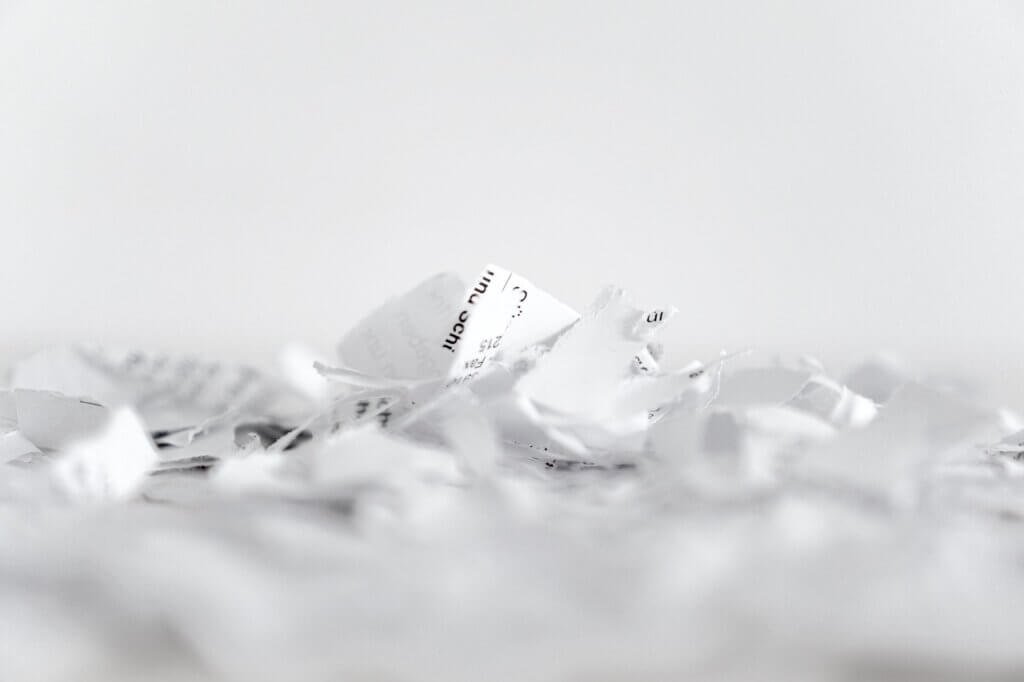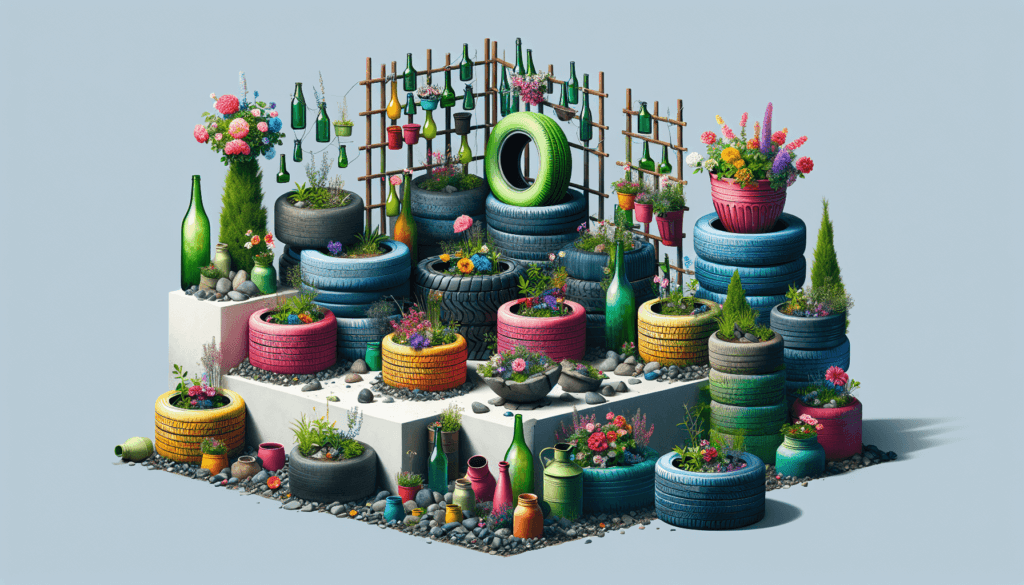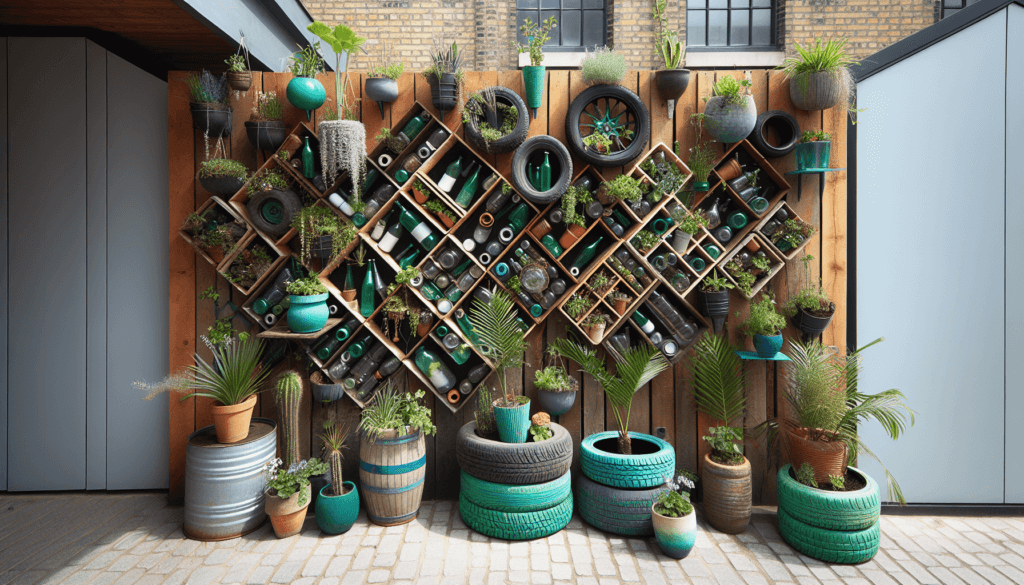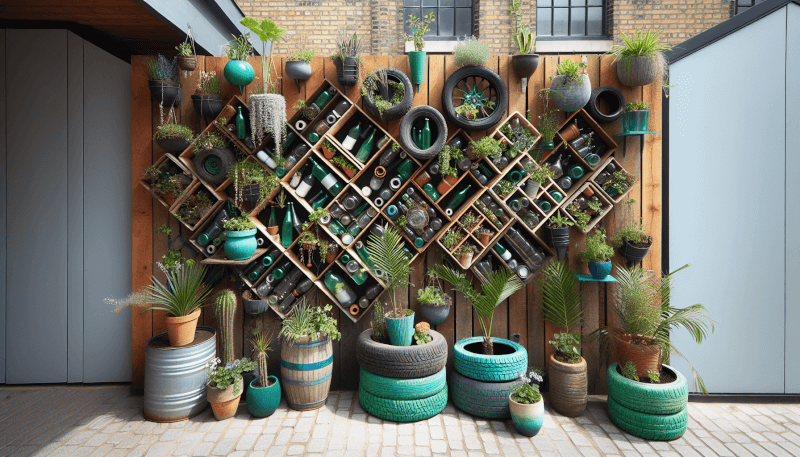Transform your urban garden into a sustainable oasis by discovering innovative ways to repurpose everyday items. This article explores the endless possibilities of using recycled materials in your garden, guiding you through a world of creativity and resourcefulness. From turning old pallets into stylish planters to repurposing plastic bottles as hanging containers, you’ll be inspired to give new life to discarded objects while adding a touch of uniqueness to your urban green space. Get ready to unleash your inner artist as you embark on an eco-friendly gardening adventure!

Vertical Gardening
Vertical gardening is a fantastic way to maximize limited space in your urban garden. By utilizing the vertical space available to you, you can grow a wide variety of plants and add a beautiful green touch to your surroundings. There are several options for creating a vertical garden, including hanging containers, vertical planters, and living walls.
Hanging containers
Hanging containers are an excellent choice for small spaces or when you want to create a striking visual display. You can use a variety of recycled materials for this purpose, such as tin cans or plastic containers. Simply drill holes in the bottom for proper drainage and attach them to a sturdy support system. Hanging containers are perfect for growing colorful flowers or herbs that can cascade down and create an inviting ambiance.
Vertical planters
Vertical planters are an ideal solution if you want to grow a larger number of plants in a limited space. One popular option is to repurpose wooden pallets as vertical planters. By attaching pots or containers to the pallet boards, you can create a stunning vertical garden. Another option is to use old drawers, which can be stacked vertically and filled with soil. Vertical planters are not only functional but also provide an interesting focal point in your garden.
Living walls
Living walls, also known as green walls, are becoming increasingly popular in urban gardening. They are essentially vertical gardens that are created by attaching plants to a structure or wall. You can use a variety of materials to make your living wall, such as recycled pallets, PVC pipes, or even old gutters. Living walls not only add a visually appealing element to your garden but also provide numerous environmental benefits, including improved air quality and insulation.
DIY Planters
Creating your own planters from recycled materials is not only cost-effective but also a fun and creative way to personalize your urban garden. There are several simple yet stylish options to choose from when it comes to DIY planters, including tin cans, pallets, and old drawers.
Tin cans
Tin cans are an excellent choice for small plants or herbs. To repurpose them into planters, make sure to clean and remove any labels. You can paint the cans with bright colors or decorate them with adhesive patterns for an added touch of flair. Remember to drill drainage holes in the bottom to ensure proper water flow. Tin can planters are versatile and can be easily hung or placed on a ledge.
Pallets
Wooden pallets are a popular choice for creating unique and rustic planters. They can be transformed into vertical or horizontal planters, depending on your preference. To make a vertical planter, attach pots or containers to the pallet boards, ensuring that there is proper drainage. For a horizontal planter, lay the pallet flat and fill each opening with soil. Pallet planters are not only functional but also add a touch of charm to any garden.
Old drawers
Don’t throw away those old, unused drawers! They can be repurposed into stylish planters that are sure to catch the eye. Stack the drawers vertically and drill holes in the bottom for drainage. Fill each drawer with soil and plant your favorite flowers, herbs, or vegetables. You can even paint or stain the drawers to match your garden’s aesthetic. Old drawers add a unique and vintage touch to your urban garden.
Upcycled Trellises
Trellises are essential for supporting climbing plants and adding vertical interest to your garden. Instead of buying new trellises, consider upcycling materials to create your own unique designs. Bicycle wheels, old ladders, and chicken wire with wood frames are just a few options for making your own trellises.
Bicycle wheels
Old bicycle wheels can be repurposed into stunning trellises for climbing plants. You can mount them vertically or horizontally, depending on the space you have available. Attach wires or strings to the spokes of the wheel and secure them to a support structure, such as a fence or wall. Climbing plants like peas, beans, or morning glories will thrive on these upcycled trellises, adding a whimsical touch to your garden.
Old ladders
If you have an old, unused ladder lying around, don’t let it go to waste. Transform it into a functional trellis by leaning it against a wall or fence. You can secure the ladder using screws or hooks, ensuring stability. As the plants grow, they will naturally climb the rungs of the ladder, creating a beautiful vertical display. Old ladders add a charming and rustic element to your garden, especially when adorned with colorful blooms.
Chicken wire and wood frames
For a more traditional-looking trellis, consider using chicken wire and wood frames. Create a frame using recycled wood, such as old fence pickets or salvaged pallet boards. Attach chicken wire to the frame, ensuring it is taut and secure. This type of trellis is ideal for growing climbing roses, cucumbers, or any other vine-like plants. Additionally, the combination of wood and wire adds an elegant touch to your garden.
Recycled Watering Systems
Watering your garden efficiently is crucial, especially in dry urban environments. Instead of relying solely on traditional watering methods, consider implementing recycled watering systems that are both eco-friendly and highly effective. Rain barrels, drip irrigation from plastic bottles, and self-watering containers are three innovative solutions for conserving water.
Rain barrels
Rain barrels are an excellent way to collect and store rainwater for your garden. They can be made from various recycled materials, such as large plastic drums or food-grade containers. Simply place the rain barrel beneath a downspout or gutter to catch rainwater. Attach a spigot or tap near the bottom for easy access to the collected water. Rain barrels not only conserve water but also provide a natural and untreated water source for your plants.
Drip irrigation from plastic bottles
Plastic bottles can be repurposed into a simple and efficient drip irrigation system. This method is particularly useful for individual plants or rows of small plants. To create a drip irrigation system, poke small holes into the bottom of a plastic bottle. Bury the bottle next to the plant, making sure the holes are near the plant’s roots. Fill the bottle with water, and it will slowly release moisture directly to the roots, minimizing water waste.
Self-watering containers
Self-watering containers are a practical solution for busy gardeners or those who have limited access to water sources. These containers are typically made of recycled plastic and incorporate a reservoir at the bottom that holds water. A wicking system, such as a string or fabric, draws water up into the soil, providing consistent moisture to the plant’s roots. Self-watering containers are a great way to efficiently water your plants while minimizing water usage.

Composting with Recycled Materials
Composting is a valuable practice in any garden, as it helps enrich the soil and reduce waste. By composting with recycled materials, you can contribute to a more sustainable and environmentally friendly gardening approach. There are several options for creating compost bins or using recycled materials for vermicomposting.
Compost bin from wooden pallets
Wooden pallets can be easily repurposed into a compost bin. Simply secure four pallets together using screws or wire to create a square or rectangular structure. Make sure the pallets are sturdy and have adequate spacing for airflow. This type of compost bin allows organic waste to decompose naturally while providing easy access for turning and aerating the compost.
Vermiculture using plastic containers
Vermiculture, also known as worm composting, is an excellent way to turn your kitchen scraps into nutrient-rich compost. Plastic containers, such as large storage bins or even old rubbermaid containers, can be used for vermicomposting. Drill small holes at the bottom for drainage and ventilation. Fill the container with bedding materials, such as shredded newspaper and cardboard, and introduce red composting worms. These worms will help break down the organic matter and produce valuable compost for your garden.
Recycled Plant Markers
Keeping track of your plants in the garden is essential, especially when it comes to maintaining proper care and organization. Instead of purchasing plant markers, consider making your own using recycled materials. Popsicle sticks, painted rocks, and wine corks are all creative options for DIY plant markers.
Popsicle sticks
Popsicle sticks are versatile and readily available for repurposing as plant markers. Simply write the names of your plants on the sticks using permanent markers or paint. You can also decorate the sticks with bright colors or patterns to add a touch of personality to your garden. Popsicle stick plant markers are not only functional but also a fun and inexpensive way to personalize your space.
Painted rocks
If you have smooth rocks or pebbles in your garden, why not transform them into unique plant markers? Select rocks of similar size and paint them with acrylic or outdoor paint. Write the names of the plants or use creative symbols to represent different species. You can also use various colors to differentiate between herbs, veggies, or flowers. Painted rock plant markers are both charming and durable, with the added benefit of beautifully blending into the natural surroundings.
Wine corks
Wine corks can be repurposed into adorable and eco-friendly plant markers. Simply carve or write the names of your plants onto the corks using a permanent marker or knife. Attach a small wooden stick or skewer to the bottom of the cork for easy insertion into the soil. Wine cork plant markers add a touch of rustic elegance to your garden, and they are an excellent way to reuse materials that would otherwise go to waste.

Creative Mulch Ideas
Mulch plays an important role in maintaining soil moisture, preventing weed growth, and enhancing the overall appearance of your garden. Instead of relying on traditional mulching materials, consider using recycled materials that add a unique and creative touch to your urban oasis. Newspaper and cardboard, shredded paper, and grass clippings and leaves are all excellent mulching options.
Newspaper and cardboard
Newspaper and cardboard are readily available and can be used as an effective mulch alternative. Lay several layers of newspaper or flattened cardboard directly onto the soil, making sure to overlap the edges. Wet the layers thoroughly to prevent them from blowing away, and then cover them with a layer of organic material, such as leaves or wood chips. Newspaper and cardboard mulch not only suppress weed growth but also help retain moisture in the soil.
Shredded paper
Shredded paper from your office or unwanted documents can be repurposed into mulch for your garden. Make sure to use non-glossy, non-colored paper without any chemical inks. Spread a layer of shredded paper around your plants, being careful not to smother them. Water the shredded paper thoroughly to prevent it from blowing away. Shredded paper mulch is a fantastic way to recycle paper waste while providing insulation and weed control.
Grass clippings and leaves
Grass clippings and fallen leaves can be easily repurposed as mulch in your urban garden. Instead of bagging up your grass clippings, leave them on the lawn after mowing. Spread a thin layer of grass clippings around your plants to retain moisture and suppress weed growth. Fallen leaves can also be collected and spread as a natural mulch. Both grass clippings and leaves break down over time, enriching the soil with essential nutrients.
Recycled Garden Decor
Adding decorative elements to your urban garden not only enhances its visual appeal but also creates a unique and personalized space. Instead of purchasing new garden decor, consider repurposing recycled materials to create beautiful and eco-friendly pieces. Bottle wind chimes, succulent wreaths made from old frames, and sculptures from scrap metal are just a few creative ideas to explore.
Bottle wind chimes
One of the most charming and whimsical ways to recycle bottles is by transforming them into wind chimes. Start by collecting several glass bottles in various colors and sizes. Remove the labels and clean the bottles thoroughly. Create a hanger using recycled wire or string and attach it to the bottle’s neck. Hang the bottles at different lengths from a sturdy structure, such as a tree branch or pergola. As the wind blows, the bottles will gently clink together, creating a soothing and delightful sound.
Succulent wreaths made from old frames
If you have old picture frames lying around, repurpose them into stunning succulent wreaths. Remove the glass or any other backing from the frame, leaving only the outer frame intact. Attach a piece of chicken wire to the frame using staples or wire. Fill the wire frame with a mixture of soil and succulent plants, pressing the plants securely into the wire. Hang the wreath on a wall or door, making sure it receives adequate sunlight. Succulent wreaths made from old frames are not only visually appealing but also low-maintenance, as succulents require minimal watering.
Sculptures from scrap metal
If you have a knack for sculpture or enjoy sculptural art, consider using scrap metal to create unique and eye-catching pieces for your urban garden. Look for discarded metal objects, such as old tools, car parts, or industrial scraps. With some imagination and welding skills, you can transform these materials into stunning sculptures. From abstract art to intricate designs, scrap metal sculptures add a touch of industrial charm and creativity to your outdoor space.

Repurposed Garden Furniture
Creating a comfortable and inviting seating area in your urban garden is essential to fully enjoy the outdoors. Instead of purchasing new furniture, repurpose recycled materials to create unique and eco-friendly seating options. Old tires as seating, pallet benches and tables, and upcycled wooden crates as plant stands are all creative choices for repurposed garden furniture.
Old tires as seating
Give old tires a new lease on life as stylish and durable seating options in your garden. Start by cleaning the tires thoroughly and removing any dirt or debris. Paint the tires in bright colors or patterns to add a playful touch. Place a cushion or outdoor fabric on top of the tire, securing it with fabric glue or velcro. Stack multiple tires on top of each other to create seating height. Old tire seating adds a fun and vibrant element to your garden while diverting materials from the landfill.
Pallet benches and tables
Wooden pallets can be repurposed into versatile and budget-friendly benches and tables for your garden. Start by sanding the pallets to remove any splinters or rough edges. Arrange them horizontally and attach the pallets together using screws or nails. For added comfort, place cushions or weather-resistant fabric on top of the pallets. To create a table, stack the pallets vertically and secure them with screws or brackets. Pallet benches and tables are not only functional but also contribute to a rustic and environmentally friendly garden aesthetic.
Upcycled wooden crates as plant stands
Wooden crates that would otherwise end up in the trash can be transformed into charming and functional plant stands. Look for crates of different sizes and configurations. Clean them thoroughly and make any necessary repairs. Stack the crates vertically, ensuring stability and balance. Fill each crate with soil and plant your favorite flowers, herbs, or succulents. Upcycled wooden crates as plant stands add height and visual interest to your garden, allowing you to showcase your favorite plants in a unique and eco-friendly way.
Recycled Pathways
Creating pathways in your urban garden not only adds functionality but also enhances the overall visual appeal. Instead of using traditional materials, such as concrete or bricks, consider repurposing recycled materials for your pathways. Broken concrete, wine bottle edging, and recycled brick pavers are all innovative choices.
Broken concrete
If you have broken concrete from previous construction projects or old sidewalks, repurpose them to create a unique and rugged pathway in your garden. Arrange the broken pieces strategically, leaving equal spacing between them. Fill the gaps with fine gravel or small stones for a polished and stable surface. Broken concrete pathways add character and texture to your garden, giving it a distinct and quirky charm.
Wine bottle edging
Wine bottle edging is a creative and eco-friendly way to delineate your pathways. Collect empty wine bottles of various colors and sizes. Dig a shallow trench along the desired path and place the wine bottles neck-first into the soil. Make sure the bottles are secure and level with the ground. Wine bottle edging not only provides a visual delineation but also adds a whimsical and eclectic touch to your garden.
Recycled brick pavers
If you come across discarded bricks or have access to salvaged materials, repurpose them into recycled brick pavers. Clean the bricks thoroughly and lay them in the desired pattern, such as herringbone or basketweave. Fill the gaps between the bricks with sand, gravel, or a mixture of both. Compact the pavers firmly to ensure stability. Recycled brick pavers add a timeless and classic element to your garden, providing a durable and visually pleasing pathway for years to come.
With these creative ways to use recycled materials in your urban garden, you can enjoy a beautiful and sustainable outdoor space that reflects your unique style. Whether it’s vertical gardening with hanging containers and living walls, DIY planters made from tin cans or pallets, or repurposed garden furniture and pathways, there are endless possibilities to transform your garden using recycled materials. By incorporating these eco-friendly practices into your gardening routine, you will not only reduce waste but also inspire others to embrace sustainable living and create a greener future.


